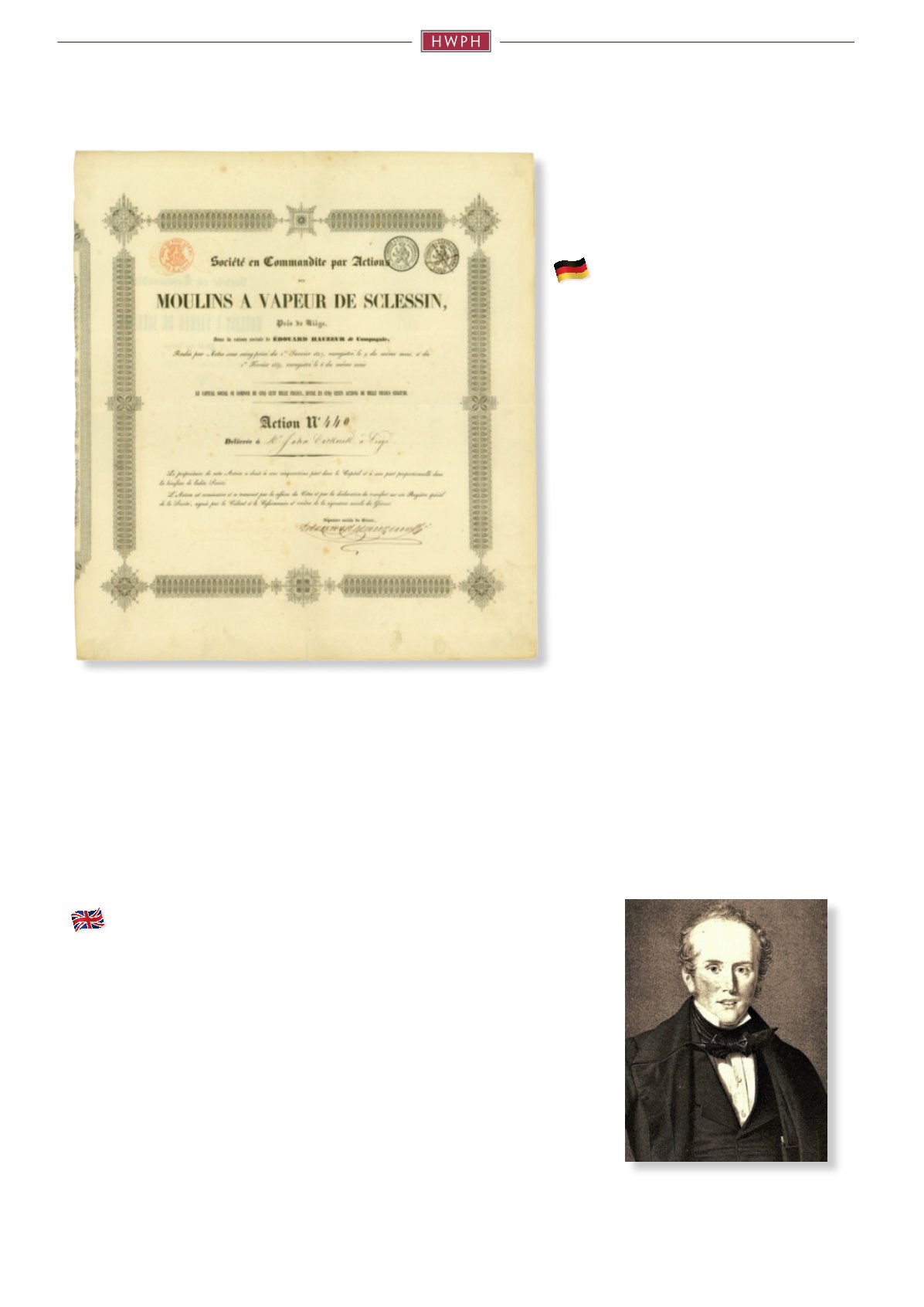

13
Los 493 Société en Commandite par Actions des Moulins a Vapeur de Sclessin, Prés de Liége, Sous la raison soci- ale de Édouard Hauzeur & CompagnieLiége, 1 February 1839, Share of 1,000 Francs, #440, 40.2 x 36.5 cm, black, beige, folds,
tears up to 2 cm, condition VF, original signatures, i
ssued to John Cockerill, only 500 shares
issued, R12.
The company operated a steam mill in Sclessin, a district of Liége.
John Cockerill
was born on August 3, 1790, in Haslington, Lancashire. Already in his early years
he travelled all over Europe with his family and in 1797, he landed in Verviers. Cockerills father
built spinning machines there. From 1802 on, John also worked in his fathers company and in
1807 he became an entrepreneur himself together with his brother James. John equipped a facto-
ry that James founded in Seraing. Besides blast furnaces there were a machine manufacturer, two
mineral coal mines, one ore mine and a boiler maker. The entire complex employed a total of
2,500 workers. The company was one of the first manufacturers of steam engines on the Euro-
pean continent. James sold his shares in the company to the King of the Netherlands in 1825. In
1833 John assumed those shares and from this time on was sole owner of the company. Only six
years later the company was shaken by a financial crisis from which it was rescued by John’s brot-
her-in-law, Konrad Gustav Pasteur. In 1840 John passed away during travel in Warszaw. The com-
pany went into liquidation. Pastor sold everything except for the factories in Seraing and Liege.
Thus he was able to save the core of the enterprise, out of which the above-named company was
built a short while thereafter. During the following decades the company developed into a big mi-
ning and diversified corporation. After WW II, Cockerill went into several fusions: first with
Qugree-Marihaye and Ferblatil (1955), then with La Providence (1966), a little later with N.V. Métallurgie d’Espérance-Langdoz (1970),
and finally with La Sambre into the current Cockerill-Sambre.
Minimum bid: 1,000 €
Société en Commandite par Actions des Moulins a Vapeur de Sclessin, Prés de Liége, Sous la raison sociale de Édouard Hauzeur & CompagnieLüttich, 01.02.1839, Action de 1.000 Francs,
#440, 40,2 x 36,5 cm, schwarz, beige, Knick-
falten, Randeinrisse bis 2 cm, Erhaltung VF, OU,
ausgestellt auf John Cockerill, Auflage nur 500
Stück, R12.
Die Gesellschaft betrieb eine Dampf-
mühle im Lütticher Stadtteil Sclessin.
John Cockerill
wurde am 03.08.1790 in Hasling-
ton in Lancashire geboren. Schon in jungen Jah-
ren kam er mit seiner Familie quer durch Europa
und landete 1797 in Verviers. Cockerills Vater
baute dort Spinnmaschinen. Ab 1802 arbeitet
auch John in der väterlichen Firma mit. 1807
macht er sich zusammen mit seinem Bruder Ja-
mes selbständig. James gründete in Seraing eine
Fabrik, die von John eingerichtet wurde. Dort be-
fanden sich neben Hochöfen, einem Stahl- und
Walzwerk auch eine Maschinenfabrik, zwei
Steinkohlegruben, eine Erzgrube und eine Kes-
selschmiede. Insgesamt standen 2.500 Personen
in Lohn und Brot. Das Unternehmen war einer
der ersten Hersteller von Dampflokomotiven auf
dem europäischen Kontinent. James veräußerte
seine Anteile an der Firma 1825 an den König
von Holland. 1833 übernahm John Cockerill
dann die Anteile und war fortan alleiniger Besit-
zer der Firma. Nur sechs Jahre später wurde die Firma während einer schweren Finanzkrise erschüttert, aus der sie Cockerills Schwager,
Konrad Gustav Pasteur herausführte. 1840 verstarb Cockerill während einer Reise in Warschau. Das Unternehmen ging in Liquidation.
Pastor veräußerte alles bis auf die Werke in Seraing und Lüttich. Hierdurch gelang es ihm den Kern des Unternehmens zu retten. Aus
diesem wurde kurze Zeit später die obige Gesellschaft formiert. In den folgenden Jahrzehnten entwickelte sich die Gesellschaft zu ei-
nem großen Bergbau- und Mischkonzern. Nach dem Zweiten Weltkrieg fusionierte Cockerill gleich mehrfach. Zunächst mit Qugree-
Marihaye und Ferblatil (1955), dann mit La Providence (1966), später mit N. V. Metallurgique d’Esperance-Langdoz (1970) und schließ-
lich mit La Sambre zur heutigen Cockerill-Sambre.
Mindestgebot: 1.000 €
John Cockerill


















